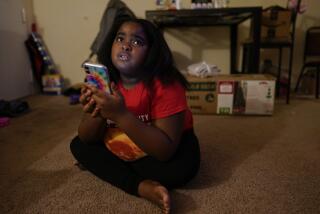Childhood disorder prompts study of infection link to mental illness
- Share via
Brody Kennedy was a typical sixth-grader who loved to hang out with friends in Castaic and play video games. A strep-throat infection in October caused him to miss a couple of days of school, but he was eager to rejoin his classmates, recalls his mother, Tracy.
Then, a week after Brody became ill, he awoke one morning to find his world was no longer safe. Paranoid about germs and obsessed with cleanliness, he refused to touch things and showered several times a day. His fear prevented him from attending school, and he insisted on wearing nothing but a sheet or demanding that his mother microwave his clothes or heat them in the dryer before dressing.
So began a horrific battle with a sudden-onset mental illness that was diagnosed as pediatric autoimmune neuropsychiatric disorder associated with streptococcus, or PANDAS. The puzzling name describes children who have obsessive-compulsive disorder that occurs suddenly — and often dramatically — within days or weeks of a simple infection, such as strep throat.
“He washed his hands over and over and was using hand-sanitizer nonstop,” said Tracy Kennedy, who has home-schooled her 11-year-old son since early November. “He had never been like this before. Ever. He just woke up with it.”
The bizarre illness, first recognized in the mid-1990s, has been cloaked in controversy. Now, however, studies are reinforcing the belief that some psychiatric illnesses can be triggered by ordinary infections and the body’s immune response. While the theory remains unproved, the research raises the possibility that some cases of mental illness might be cured by treating the immune system dysfunction.
“Some people get sick with whatever infection, and they recover and they’re fine,” says M. Karen Newell Rogers, an immunologist at Texas A&M; Health Science Center College of Medicine in Temple, Texas, who studies such illnesses. “Other people get sick and recover, but they are not the same.”
PANDAS is thought to be caused by antibodies generated as a result of an infection, usually strep. Normally, an infection causes the body to generate antibodies that fight the infection and promote healing. But in PANDAS, the antibody response is thought to go awry, attacking brain cells and resulting in OCD symptoms.
A greater understanding of the link between strep and OCD has opened the door to the study of other psychiatric or neurological illnesses that may be linked to improper immune response, including cases of autism, schizophrenia and anorexia.
“The whole area of mental illness caused by infections is being looked at more closely because of PANDAS,” says Dr. Michael A. Jenike, a professor of psychiatry at Harvard Medical School and chairman of the International OCD Foundation’s scientific advisory board. “If you can prevent lifelong suffering by using antibiotics or some acute intervention, that would be huge.”
Little understood disorder
PANDAS is generally poorly understood in the medical field, said Dr. Margo Thienemann, a Palo Alto child psychiatrist who has treated several cases. There is no test to help doctors diagnose it, although the National Institute of Mental Health says that PANDAS can be identified after two or three episodes of OCD or tics that occur in conjunction with strep infection — a vague guideline that results in much confusion.
Thienemann says patients tend to fall between the cracks of psychiatry and immunology. But early diagnosis is important.
“In psychiatry, we generally spend our time treating diseases without knowing the reason they happen,” she says. “With PANDAS we are able to see the cause of a problem rather than the downstream effects. This is the exciting part.”
OCD affects about 1% of people and can feature a fear of contamination by germs or other substances, hoarding, intense anxiety over one’s moral behavior, tics, compulsive skin-picking or body dysmorphic disorder (obsession with some perceived bodily imperfection). The disorder tends to run in families and usually appears around the ages of 10 to 12, with a later spike in rates from age 18 to 22.
No one knows what portion of obsessive-compulsive disorder cases may be tied to PANDAS — or even how prevalent the condition may be, Jenike says.
“I used to think it was exceedingly rare,” he says. “Now I think it’s exceedingly common.”
Recent research has strengthened support for PANDAS. For instance, one study demonstrated that in mice prone to autoimmune disorders (in which the immune system attacks healthy cells), exposure to strep led to OCD-like behavior. The study was published in 2009 in the journal Molecular Psychiatry.
A 2010 Yale study found that tic symptoms worsened somewhat in children with OCD following a strep infection. That study, published in Biological Psychiatry, suggests some children are vulnerable to flare-ups of OCD symptoms when stressed by infections.
Another paper, published online in August in the Journal of Pediatrics, found that, compared with children with typical OCD, children diagnosed with PANDAS were more likely to have biological evidence of a recent strep infection, a sudden onset of psychiatric symptoms and an easing of those symptoms while taking antibiotics.
PANDAS may be caused by a mechanism similar to that of rheumatic fever, an autoimmune disorder triggered by strep infection, says Dr. Susan Swedo, a leading researcher on the condition based at the National Institute of Mental Health in Bethesda, Md., which sponsored a symposium on the disorder last year.
When an infection occurs, the body produces antibodies to fight the bacteria and clear them from the body. But in the case of rheumatic fever, the antibody response malfunctions and the immune system attacks the heart valves, joints or parts of the brain. This autoimmune response in the brain is called Sydenham’s chorea or St. Vitus’ dance, a condition that features rapid jerking movements and tics.
In PANDAS, a vulnerable part of the brain may be the target of the wayward immune response. In a 2003 study in Nature Medicine, immunologist Madeleine Cunningham of the University of Oklahoma College of Medicine reported that antibodies generated by a strep infection can bind to neurons and prompt the release of unusual amounts of dopamine and other brain chemicals. Abnormal amounts of dopamine are thought to cause tics and OCD symptoms.
But almost every child is infected with strep at some point, and most don’t develop OCD symptoms. Some researchers say that children who develop PANDAS may have a genetic vulnerability that puts them at risk. For instance, kids with PANDAS are more likely than healthy children to have a family history of rheumatic fever, which suggests an inherited vulnerability to strep infections that go awry, says Dr. Mady Hornig, who studies interactions between the brain and immune system at Columbia University in New York.
Uncertainty and skepticism
The link between strep and OCD is hard to make “because it’s hit and run,” Hornig says. Children with PANDAS symptoms typically have recovered from their strep infection by the time they see a psychiatrist or neurologist, she says. An anti-streptococcal antibody test can show whether the child has had a strep infection within the last few months. But some children without OCD symptoms also have high antibodies to strep, and some children with PANDAS have no evidence of strep infection.
There are also case reports in the medical literature that infections besides strep, such as mononucleosis and a type of pneumonia caused by mycoplasma, may give rise to PANDAS, Jenike says.
All of this uncertainty makes many doctors skeptical.
One of them is Dr. Harvey Singer, director of pediatric neurology at the Johns Hopkins Hospital Children’s Center in Baltimore, who has studied the illness. Children diagnosed with PANDAS actually may have obsessive-compulsive disorder that flares up when they are stressed by an event or illness, he says.
And some researchers have tried and failed to find a link between infection and OCD. A study published this year in the Journal of the American Academy of Child and Adolescent Psychiatry compared children with PANDAS to other children with OCD or Tourette’s syndrome and found no link between worsening symptoms and strep infections in either group.
Still, some doctors are using antibiotics to try to rid the body of any lingering strep infection as a way to treat PANDAS or prevent OCD symptoms from returning if the child is exposed to strep again. Authorities at NIMH have criticized this practice because it may contribute to antibiotic resistance.
A more invasive treatment — called intravenous immunoglobin (IVIG) or plasmapheresis — is aimed at shutting down the strep antibody response by giving children infusions of donor plasma to prompt normal immune-system functioning.
A 1999 Lancet study showed that children with strep and OCD were helped by the therapy. But a 2000 study in the Journal of the American Academy of Child and Adolescent Psychiatry found that it did not improve symptoms and caused side effects, such as nausea and headaches. The National Institutes of Health is currently enrolling children with PANDAS in a new study to evaluate the treatment.
These approaches may be controversial in the medical community, but many patients are eager to try them. Diana Pohlman of Palo Alto credits both with pulling her 11-year-old out of a four-month-long bout of OCD that began within weeks of what seemed like a routine case of strep.
Pohlman remembers the day her then-second grader came home from school and began running frantically through the house switching off the lights because, he said, “we’ll get radiation.” The TV had to be turned off too, he insisted, because “there’s poison in there.”
“It was like living in an insane asylum,” says Pohlman, who declined to share her son’s name to protect his privacy. She was forced to curtail her work as a paralegal to accompany her son to school, the only way he could attend classes.
It took several months and visits to a half-dozen doctors for the boy to be diagnosed with PANDAS. He was treated with antibiotics to arrest any lingering strep infection and began to improve almost immediately, Pohlman says. Over the next two years, he also had IVIG and behavioral counseling. The result: His anxiety, obsession and rumination faded away, Pohlman says.
“There is still a compulsive quality to him, but he’s back to normal,” she says. “He’s a straight-A student and a brown belt in martial arts.”
Brody Kennedy, meanwhile, has received therapy to help him cope with stress and overcome his fear of germs. He is taking antipressant and antipsychotic medications and is “70% better,” Tracy Kennedy says. He hopes to return to school soon.
More study ahead
Though many mysteries still surround PANDAS, growing interest in the illness has cleared a path for more research on the connection between infection and mental illness. For instance, several studies have linked respiratory infections in pregnant women to higher rates of schizophrenia and autism in their offspring. Other researchers have reported cases of anorexia in teens that appear suddenly after a strep infection.
“This is not some way-out idea,” Hornig says. “But I think we have a lot of work ahead of us.”






